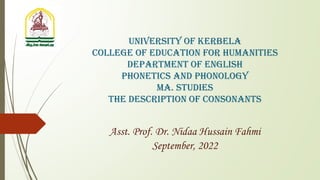
The_Description_of_Consonants.pptx
- 1. University of Kerbela College of Education for Humanities Department of English phonetics and phonology MA. Studies The Description of consonants Asst. Prof. Dr. Nidaa Hussain Fahmi September, 2022
- 2. Describing consonants systematically ⮚ A consonant is a speech sound produced with differing amounts of obstruction of the air stream in the mouth using combinations of adjustments of the lips, teeth, tongue, and velum. ⮚ They are produced by certain interference of the organs of speech with the breath and this makes their description and recognition easy. ⮚ Consonant sounds are considered important because no speech is possible without them. Consonants are classified along three major dimensions: Place of articulation Manner of articulation Voicing
- 3. Criteria for the Description of Consonants These are the places where the constrictions and obstructions of air occur. Place of articulation
- 4. The manner of articulation of a sound is how the airstream is affected as it goes through the vocal tract. Essentially, the manners of articulation describe how air is modified to create different speech sounds. There are six different manners of articulation in English that will distinguish one consonant sound from the other. ⮚ Stop ⮚ Fricative ⮚ Affricate ⮚ Approximant (Liquids and Glides) ⮚ Nasal ⮚ Lateral Manner of articulation
- 5. APPROXIMANT CONSONANT SOUNDS The APPROXIMANTS are those consonants which are most similar to vowels in their articulation. Approximant articulation involves one articulator approaching another but without the tract becoming narrowed to such an extend that turbulent airflow occur. RETROFLEX (r sound) The tongue tip is curled up toward the post alveolar region (the area immediately behind the alveolar ridge). There are two different ways to create an “r” sound, and although the tongue placement is quite different between the two, the sound they produce is very similar. An important aspect of the American [r] sound is that the tip of tongue never touch the tooth ridge during this sound. Method 1 (solid): The back tongue is raised so the sides of the tongue touch the back teeth. The center of the back of the tongue is lower and the air travels through this groove. Method 2 (dashed): The tip of the tongue is raised and curled back behind the tooth ridge while the back of the tongue stays low.
- 6. Semi-vowel [w] and [j] The [w] sound and [j] sound are the only two semi-vowels (also commonly called glides) in English. These sounds can be created with slightly greater restriction in the vocal tract than vowels, but less restriction than most other consonants.
- 7. In the production of consonants the vocal cords take two basic positions: (1) When they are drawn together they will vibrate because the air pushes them apart repeatedly in order to pass through, then the consonant is voiced (Yule, 2006: 30). (2) When the vocal cords are spread apart, the air that is pushed from the lungs will pass between them freely without obstacles and they do not vibrate, then the consonant produced in this way is voiceless (ibid.). ⮚Sounds which are made with vocal fold vibration are said to be voiced. ⮚Sounds made without vocal fold vibration are said to be voiceless. Voicing (Sonorization)
- 8. vocalic sounds are articulated “with an oral cavity in which the most radical constriction does not exceed that found in the high vowels/ɪ/ and /u/ and with vocal cords that are positioned so as to allow spontaneous voicing; in producing non-vocalic sounds one or both of these conditions are not satisfied” (Chomsky and Halle,1968:302). Vocalic sounds include the voiced liquids and voiced vowels. Non-vocalic sounds include glides, nasal consonants, obstruents, voiceless liquids and voiceless vowels. Vocalic and Non-vocalic
- 9. The categories of sounds are classified depending on their noise component. The sounds whose narrowing on the air stream through the vocal tract is sufficient to cause noise are OBSTRUENTS. This category is composed of plosives, fricatives, and affricates. The voiced sounds in which there is no noise component are called SONORANTS. They include voiced nasals, approximants, and vowels. An obstruent is a speech sound such as [k], [ʤ], or [f] that is formed by obstructing airflow. Obstruents contrast with sonorants, which have no such obstruction and so resonate. All obstruents are consonants, but sonorants include both vowels and consonants. Obstruents and Sonorants
- 10. the IPA chart ⮚The International Phonetic Alphabet (IPA). ⮚The phonetic symbols used are suggested by the International Phonetic Association, it is an organization founded in 1886 by a group of European phoneticians. ⮚The International Phonetic Alphabet (IPA) is the set of the symbols and diacritics that have been officially approved by International Phonetic Association. ⮚IPA aims to symbolize all the distinctive sounds in languages. The intent is to represent the sounds by symbols that serve to distinguish one word from another in a language. This is done by using ordinary letters of the Roman alphabet or simple modifications of these letters.
- 11. International Phonetic Association recommends that a phonetic transcription should be enclosed in square brackets [ ]. A transcription that stands for only specific phonological contrasts may be enclosed in slashes / /.
- 14. b baby, labor, cab d day, kid ʤ just, badger, fudge ð then, either, bathe f foe, tough, buff g go, dagger, bag h hot, ahead j yes, vineyard k lacquer, flock, skin kʰ cat, keep, account l law, hollow l̩ pedal, battle, final m mat, hemp, hammer, rim n new, tent, tenor, run n ̩ button, satin, kitten ŋ rung, hang, swinger p lapse, top, lip, speed pʰ pay, pet, appear r rope, arrive s sad, mist, kiss ʃ shoe, mission, slush t mat, stick, late tʰ toe, attack ɾ later, catty, riddle tʃ batch, nature tʃʰ choose, chin, achieve θ thin, ether, bath v vat, never, cave w wet, software z zoo, easy, buzz ʒ vision, azure, beige ʔ button, kitten, satin (glottal stop)